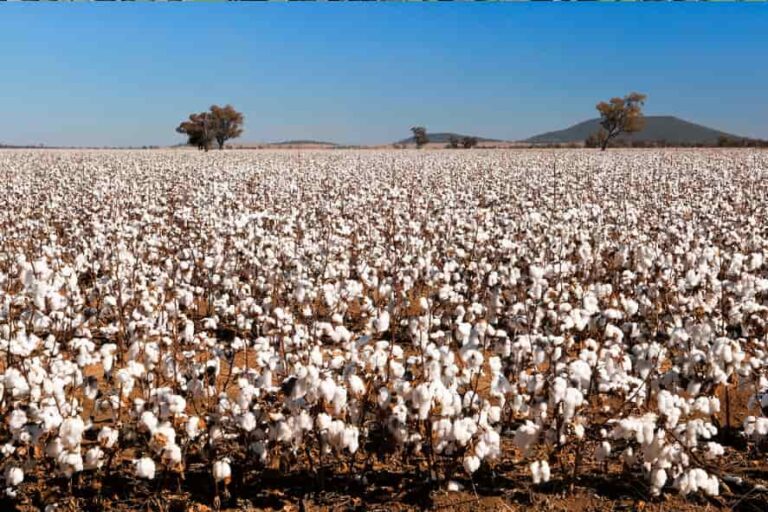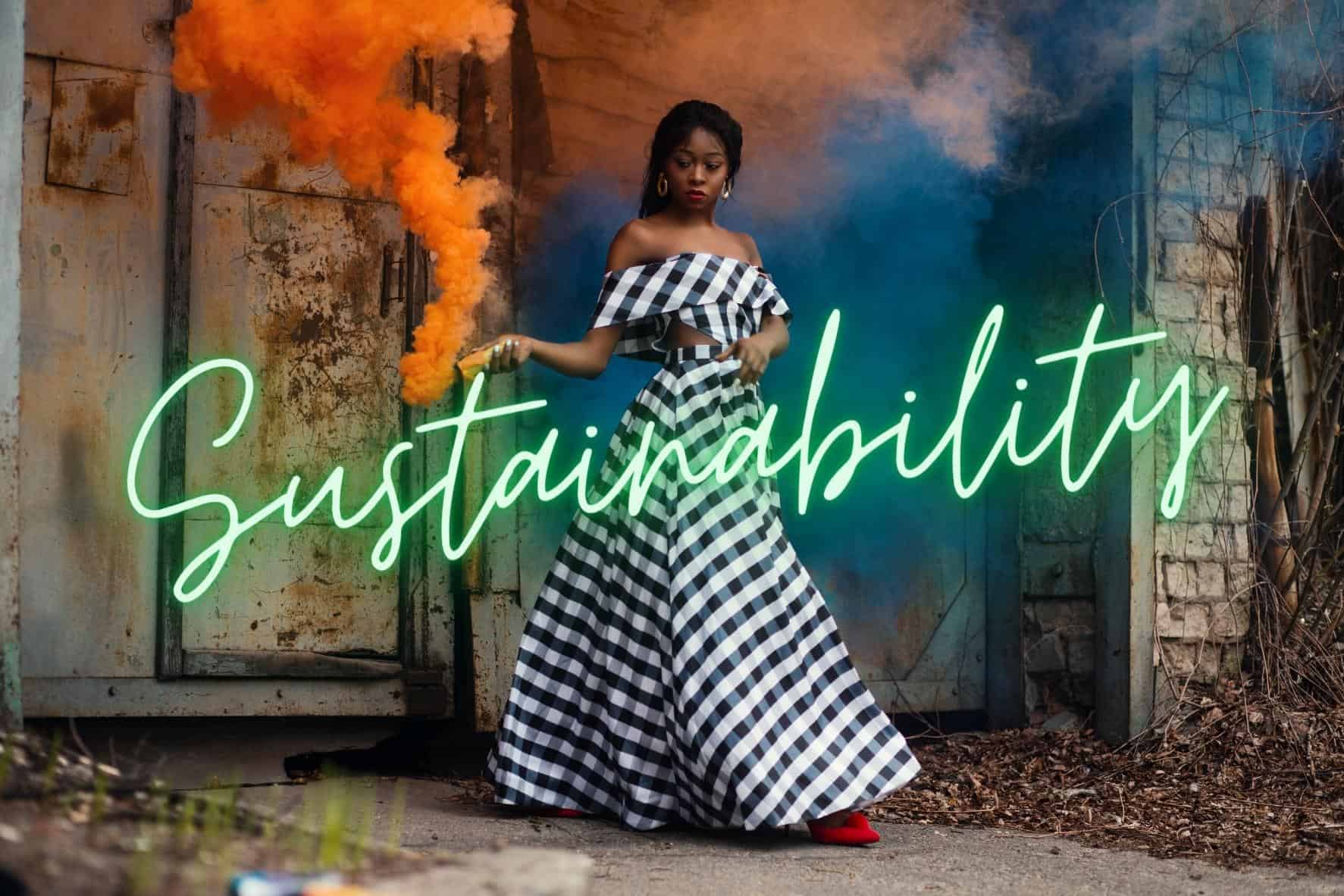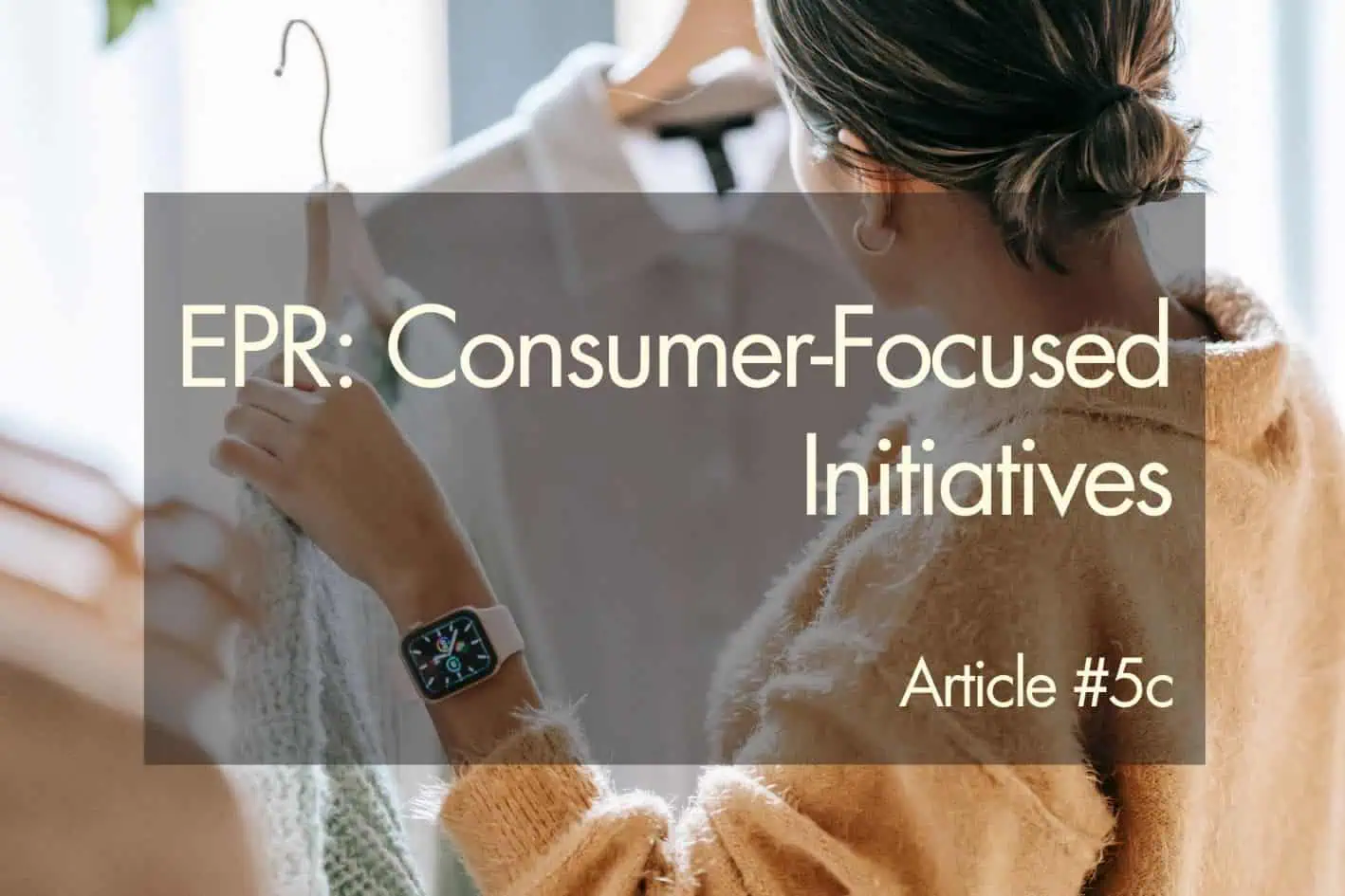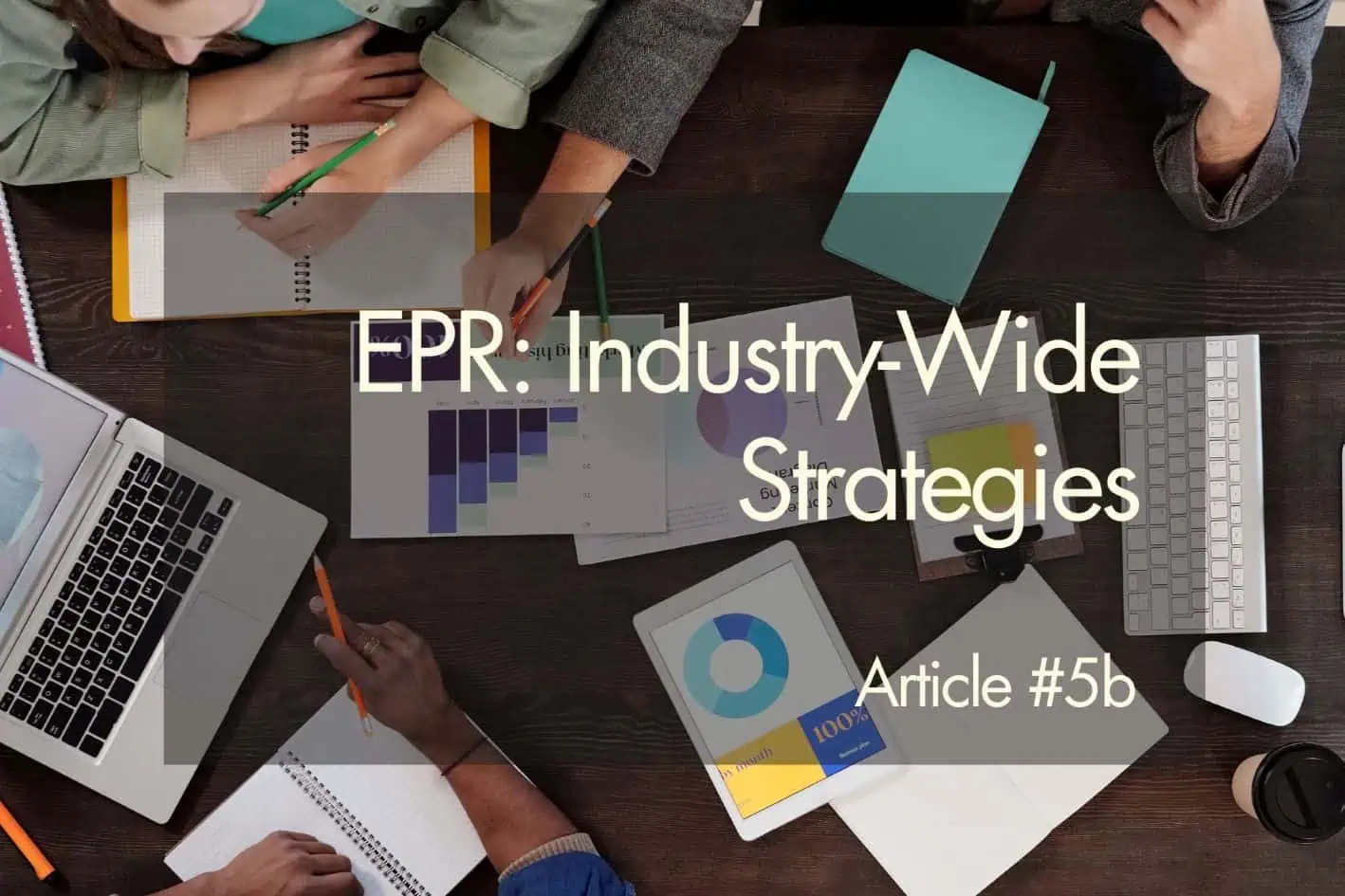Sustainable fashion is an incredibly important and complex topic. This subject has become even more pressing in the past few years with the increasing threat of climate change. With a limited amount of time left to mitigate the intensity of adverse climate effects, there has been increased consumer interest and demand for sustainable and ethical products.
The fashion industry has been a major contributor to climate change. In this post, we’re going to explore some of the most popular questions we’ve received about sustainable fashion including:
2. Can clothing be environmentally friendly?
3. Should we only buy second-hand?
Inventions resulting from the textile industry
4. Are all natural textiles sustainable?
5. Is there a link between the cost of an item and sustainability?
6. What are the necessary components of a sustainable brand?
1. What is sustainability?
Sustainability is “meeting the needs of the present without compromising the ability of future generations to meet their own needs” (United Nations, n.d.). It’s a holistic approach that goes beyond environmentalism by also considering social equity and economic development.
The foundations of sustainability align with the three pillars of the triple bottom line (TPL):

Pillar 1: People
To be socially responsible, brands must have fair and legally compliant labor practices. There must be no exploitation of forced or child labor, and all staff must be paid living wages. Consideration should also be paid to the community or region in which a company operates, by providing benefits to local communities (Triple Bottom Line, 2022).
Pillar 2: Planet
To be environmentally responsible, brands must prioritize doing no harm. There must be an effort to minimize all environmental impacts, energy consumption, and manufacturing waste. Any toxic effluents or waste matter must be treated before being released or disposed of. This pillar supports the adoption of a life cycle analysis of products (Triple Bottom Line, 2022).
Pillar 3: Profit
In the context of sustainability and the TPL, this pillar goes beyond the internal profits earned by a company. It examines the economic benefits to society by considering the costs of all inputs (Triple Bottom Line, 2022).
2. Can clothing be environmentally friendly?
Apparel production requires fiber processing and manufacturing which results in the consumption of resources, energy, and GHG emissions. In fact, everything we do has an unavoidable carbon footprint. By just existing, the average human exhales about 2.3 pounds of CO2 on an average day (Palmer, 2015). Vigorous exercise can increase this amount by up to 8 times (Palmer, 2015).
Clothing is complicated. In addition to considerations for manufacturing and production, there are further environmental impacts incurred during the lifecycle of clothing itself. These impacts may be seen during cleaning, ironing, and the eventual disposal of the garment.
Fortunately, scientific analysis of fiber production, use, and disposal enables us to perform a full life cycle analysis (LCA) of various textiles and garments. This enables companies like Global Measure to certify the most environmentally friendly and sustainable fashion options. Certified products are tagged for easy consumer identification. Once purchased, it’s also important that consumers follow care instructions to increase the durability and longevity of their garments.

3. Should we only buy second-hand?
Second-hand is definitely a great option when available; however, there are certain things most people hesitate to buy second hand including undergarments, personal protective equipment, and items that can expire.
It is equally important that in upholding sustainable values, we don’t discourage innovation, self-expression, or art. Innovation in textile technology has advanced society in many ways:
The invention of the computer
Would you be surprised to know that weaving directly resulted in the invention of the computer?
In 1804 Joseph Marie Jacquard successfully investigated a method of automating the weaving process that would allow the speedy reproduction of ‘jacquard’ patterns using a series of punched cards.
This led to Semyon Korsakov leveraging Jacquard’s invention in 1832 to use punched cards to store and retrieve information (Punched Card, 2022). In 1884, Herman Hollerith filed a patent for a machine that could tabulate statistical computations using punched cards (National Inventors Hall of Fame, n.d.). In the early 1900s, IBM and its rivals redesigned the punch card to store more data (IBM, n.d.). “Special purpose cards and hardware”, i.e. the computer, was thus introduced in the 1930s. By the 1950s, punch cards made up 20% of IBM’s revenues and 30% of its bottom line (IBM, n.d.). Punch card computing remained in use well up to the mid-1970s (Computer programming, 2022).


Space exploration and resulting technologies
Without material innovations, space exploration would not be possible. To perform the first moonwalk, spacesuits needed to be designed with a complex list of requirements including the following (Space Suit, 2022):
– Temperature regulation
– Supply breathable oxygen
– Accommodate a communication system
– Stabilize internal pressure
– Encourage mobility despite the pressure of the suit
– Allow the collection of human waste
– Shield against UV and particle radiation
Each of these criteria required manufacturers to work innovatively with textiles. Temperature regulation alone was a complex feat. Each suit was built with a cooling system of small tubes that allowed water to circulate over the body. This led to the invention of Beta Cloth a fireproof material that currently coats the International Space Station (Tomaswick, 2020). It also resulted in the creation of polybenzimidazole (PBI) fabric that can remain stable in extremes of heat and cold – a technology currently leveraged in firefighters’ suits (Tomaswick, 2020).
Athletic enhancement and protection
Textiles and material innovations have given an edge to many athletes.
In 2008 Speedo caused an uproar when they introduced the LZR Racer. This innovative swimsuit manufactured of polyurethane and elastane-nylon compresses swimmers’ bodies and traps air creating buoyancy. In the 2008 Beijing Olympics, 98% of medal winners were wearing the LZR Racer (NASA, 2012). In fact, “more than 130 world records were broken in only the first seventeen months after the LZR became available to competitive swimmers” (MacDonald, 2017). The suits gave swimmers such a competitive advantage, that they were eventually banned by the International Swimming Federation (MacDonald, 2017).
Material innovations have also led to the creation of protective equipment in sports. Polyurethane allows athletes to play football (mostly) unscathed and for kids and adults to ride bicycles without a major risk of injury.

We’re excited to see what future innovations research into textiles and technology can bring. Fashion Exchange in Toronto is making great strides in:
– 3D body scanning and pattern design to reduce waste and enable a more accurate fit
– Technical embroidery to enable wearable technologies with possible applicable to healthcare
– Spectroscopy scanning with applications to waste identification for textile recycling
Bolt Threads in the US is making advancements with research into protein-based fibers like mycelium and spider silk.
4. Are all natural textiles sustainable?
Not always. Judging a textile solely based on its fiber origin is a one-dimensional viewpoint that will often result in a false conclusion. This would be akin to assuming that all green packaged items are eco-friendly (see our post about greenwashing) or believing that all skinny people are fit and healthy.
Aside from the origin of the base fiber source, consideration also needs to be given to how a textile is produced. This means looking at several other factors as part of a fulsome lifecycle analysis (LCA) including the following:
– Environmental impact during growth or extraction of a fiber
– Emissions to process a fiber
– Water consumption
– GHG emitted during processing
– Toxic chemicals required to process
– Circularity
– Energy required during its lifecycle for fiber care
– How a garment has been finished
– Processing methodology
– Location of fiber and textile production
Let’s talk about rubber
One example of a natural fiber with exaggerated sustainability claims is rubber.
Rubber is a natural fiber that starts as latex – the sap of the rubber tree. Chemicals are added to increase the compound’s stability. It then goes through a heat-intensive process called vulcanization which helps to strengthen the bonds in the molecules, thereby creating rubber (European Rubber Chemicals Association, n.d.).


One of the key chemicals used in rubber production is carbon disulfide. Carbon disulfide is a toxic solvent with potentially lethal consequences. At extremely high levels of exposure, carbon disulfide damages the nervous system and becomes life-threatening (U.S. Department of Health and Human Services, 1996). Workers do not need to be exposed to high levels to be affected. Other known effects aside from respiratory and cardiovascular include gastrointestinal, reproductive, endocrine, and ocular (U.S. Department of Health and Human Services, 1996). One of the most severe and often irreversible effects is neurological (U.S. Department of Health and Human Services, 1996).
“There was a famous rubber factory where they put bars on the second-story windows because so many workers had a tendency to jump out and kill themselves” (CBC The Current, 2017).
Aside from the impact on workers, there are many environmental issues associated with the production of rubber. Thailand is the world leader in natural rubber production and export. An ammonia odor is released during the drying process and has had notable adverse effects on workers and residents (Tekasakul & Tekasakul, 2006). Rubber also demands a high quantity of water during production. The wastewater that results is often not treated appropriately (Tekasakul & Tekasakul, 2006). A hazardous by-product of rubber production is polycyclic aromatic hydrocarbons (PAHs). These PAH pollutants present potentially carcinogenic and mutagenic effects to humans and animals (Desai et. al., 2020).
Although rubber is biodegradable, it has a very long rate of decomposition. Rubber shoe bottoms can take more than 80 years to decompose (Megan, 2022). Recycling is an option; however, it’s worth noting that the base ingredients cannot be fully recovered. Vulcanization is an irreversible process that combines rubber with oil, carbon fillers, and plasticizers in a method akin to baking a loaf of bread. Through pyrolysis, some of the original ingredients may be recovered. This process is energy-intensive and can result in an explosion if oxygen gets in the furnace.
What about bamboo?
It depends. Bamboo is a hardy and fast-growing plant that doesn’t require herbicides or pesticides. The method of processing bamboo into textiles is where sustainability issues can occur.

The majority of bamboo on the market is manufactured using a viscose process. This involves the extraction of the cellulose content through a chemically intensive process. Processing bamboo in this method also requires carbon disulfide, which is subject to the same detrimental issues noted above with rubber. This processing method is typically not a closed-loop process and can result in the contamination of waterways.
In North America brands are not legally allowed to label Bamboo Viscose as “bamboo”, it must be labeled as viscose (Federal Trade Commission, n.d.) (Competition Bureau of Canada, 2009). Federal charges were filed against several companies including Bed Bath & Beyond, Nordstrom, J.C. Penney, Sears, and Macy’s for incorrectly labeling products as “bamboo” (Fair, 2015) (Lemberg, n.d.).
Bamboo linen on the other hand is produced very similarly to flax linen. The cellulose is not extracted. Instead, fibers are crushed, dried, and spun into yarn. The resulting textile is very similar in feel to linen and a more sustainable option than bamboo viscose.
What about cotton?
Cotton is a loaded topic, to say the least. There is a lot of misinformation about the sustainability of cotton (including organic cotton). We’ll be exploring this in more detail in a future post.

5. Is there a link between the cost of an item and sustainability?
Sort of. Just because an item is expensive doesn’t make it sustainable. However, if something seems unreasonably cheap it should raise some questions.
Fashion supply chains are typically long and complex. Raw materials may be grown/extracted in a different country than where textiles are made, and different again from where garments are produced. Shipping and logistics are also required to warehouse materials and distribute them. Every hand that touches textile products should get paid.
As recently as 2020, reports of forced Uyghur labor in the Xinjiang region of China resulted in many fashion brands having to rethink their supply chains. Horrifying conditions of forced labor were exposed, where farmers were being forced to meet strict cotton quotas, and imprisoned Uyghurs were being forced to stitch garments (Thanhauser, 2021). A 2015 report by the Center for Research on Multinational Corporations revealed the exploitation of child labor in yarn and spinning mills in India. They found that “60% of workers at the mills it investigated in India were under-18 when they started working there” (SOMO, 2014). Violence continues to be reported against female garment workers demanding a living wage (Hoskins, 2022).
Labor issues are not limited to off-shore production. In 2017 the LA Times wrote an expose titled “Behind a $13 shirt, is a $6-an-hour worker”. The article focused on garment workers in LA-based garment factories that were exploited and paid less than the legally required minimum wage. Most workers were undocumented and had no recourse. Fashion Nova, a popular US-based fast-fashion brand has been cited by the Federal Labor Department as owing workers $3.8 million in back wages (Kitroeff, 2019).
Brands hide behind the fact that the factories used are operated by “third parties”. However, it’s the direct pressure from the heads of fashion supply chains to produce more cheaply that has driven fashion’s race to the bottom. An emphasis on quantity over quality has fueled higher production requirements and cheap labor.

6. What are the necessary components of a sustainable brand?
Sustainable fashion is a complex topic. Throughout this article, we’ve emphasized that you can’t judge brand sustainability using just one metric. It’s important to assess a brand and its subsequent products on a holistic spectrum. At Global Measure, we evaluate sustainability on a comprehensive range using several factors including:
– Company operations
– Worker rights and labor practices
– Manufacturing practices
– Factory and operating conditions
– LCA of manufactured products (see our list above with basic components of an LCA)
– Product design and development
– Circularity of products and waste
Brands must meet these criteria at a minimum, to be considered sustainable
7. Is there a way to tell if a company is sustainable?
It’s not easy for an individual to tell if a brand is sustainable without doing a lot of independent research and analysis. Fortunately, third-party certification enables customers to easily validate brands’ sustainability claims.
In an earlier post, we explored how easy it is for brands to succumb to greenwashing either through misplaced judgment or by intentionally misleading customers. It’s important to leverage holistic certifications like Global Measure’s to connect with legitimately sustainable brands.

The only way the fashion industry will see real change is if consumers use their buying power to influence production trends and brand priorities. Sustainable fashion not only makes good business sense, but it’s necessary if we want to ensure healthy conditions necessary for future generations to thrive. We encourage you to leverage Global Measure’s platform to search for and support certified sustainable and ethical brands.

Deborah King
Deborah is a sustainable fashion expert located in Toronto, Canada. She’s an Industrial Engineer with a post-grad in Sustainable Fashion Production. She grew up on the tiny island of Tortola in the British Virgin Islands, and has been sewing her own clothing since the age of 10. She founded Global Measure to help authentically sustainable and ethical fashion businesses stand out from the greenwashing noise through third-party certification.
References:
CBC The Current (Feb 9, 2017). Why rayon is killing industry workers: author Paul Blanc. CBC Radio. Retrieved on Mar 14, 2022 from https://www.cbc.ca/radio/thecurrent/the-current-for-february-9-2017-1.3972476/why-rayon-is-killing-industry-workers-author-paul-blanc-1.3972480
Chaikin, A. (Nov, 2013). Neil Armstrong’s SpaceSuit Was Made by a Bra Manufacturer. Retrieved on Mar 14, 2022 from https://www.smithsonianmag.com/history/neil-armstrongs-spacesuit-was-made-by-a-bra-manufacturer-3652414/
Competition Bureau of Canada (Mar 11, 2009). Guidance on Labelling Textile Articles Derived from Bamboo. Retrieved on Mar 14, 2022 from https://www.competitionbureau.gc.ca/eic/site/cb-bc.nsf/eng/03021.html
Computer programming (Feb 7, 2022). In Wikipedia. Retrieved on Mar 14, 2022 from https://en.wikipedia.org/wiki/Computer_programming_in_the_punched_card_era
Desai, C., Jain, K.R., Madamwar, D., Patel, A.B., Shaikh, S. (Nov 5, 2020). Polycyclic Aromatic Hydrocarbons: Sources, Toxicity, and Remediation Approaches. Retrieved on Mar 14, 2022 from https://www.frontiersin.org/articles/10.3389/fmicb.2020.562813/full
European Rubber Chemicals Association (n.d.). How is Rubber Made? Retrieved on Mar 14, 2022 from https://erca.cefic.org/how-is-rubber-made/
Fair, L. (Dec 9, 2015). Clothes by any other name: FTC challenges retailers “bamboo” claims. Federal Trade Commission. Retrieved on Mar 14, 2022 from https://www.ftc.gov/business-guidance/blog/2015/12/clothes-any-other-name-ftc-challenges-retailers-bamboo-claims
Federal Trade Commission (n.d.). Bamboo Textiles. Retrieved on Mar 14, 2022 from https://www.ftc.gov/bamboo-textiles
Green, J. (Jul 8, 2019). Inventions we use everyday that were actually created for space exploration. Retrieved on Mar 14, 2022 from https://www.usatoday.com/story/money/2019/07/08/space-race-inventions-we-use-every-day-were-created-for-space-exploration/39580591/
Hoskins, Tansy (Feb 24, 2022). Violence against women garment workers. Retrieved on Mar 14, 2022 from https://www.newagebd.net/article/163486/violence-against-women-garment-workers
Howard, Danny (Apr 4, 2010). Punchcard Loom. Retrieved on Mar 14, 2022 from shorturl.at/cjxMW
IBM (n.d.). The IBM Punched Card. Retrieved on Mar 14, 2022 from https://www.ibm.com/ibm/history/ibm100/us/en/icons/punchcard/
Kiger, P. & Spoon, M. (May 10, 2021). Top 10 NASA Inventions. Retrieved on Mar 14, 2022 from https://science.howstuffworks.com/innovation/inventions/top-5-nasa-inventions.htm
Kim, V., & Kitroeff, N. (Aug 31, 2017). Behind a $13 shirt, a $6-an-hour worker. Los Angeles Times. Retrieved on Mar 14, 2022 from https://www.latimes.com/projects/la-fi-forever-21-factory-workers/
Kitroeff, N. (Dec 16, 2019). Fashion Nova’s Secret: Underpaid Workers in Los Angeles Factories. The New York Times. Retrieved on Mar 14, 2022 from https://www.nytimes.com/2019/12/16/business/fashion-nova-underpaid-workers.html
Klimovski, C. (Feb 21, 2016). The Complete History of Nike’s Flyknit Technology. Hypebeast. Retrieved on Mar 14, 2022 from https://hypebeast.com/2016/2/nike-flyknit-technology-history
Lemberg, S. (n.d.). Bamboo Fabric or Rayon? Understanding the Difference. Lemberg Law. Retrieved on Mar 14, 2022 from https://lemberglaw.com/bamboo-fabric-rayon-products-ftc/
MacDonald, R. (Jan, 2017). “Doping on a hanger”: Regulatory lessons from the FINA elimination of the polyurethane swimsuit applied to the International Anti-Doping paradigm. Columbia Journal of Law and Social Problems. Retrieved on Mar 14, 2022 from http://blogs2.law.columbia.edu/jlsp/wp-content/uploads/sites/8/2018/04/Vol51-MacDonald.pdf
Mayer, A. (Oct 13, 2020). Inside the fight to end labor exploitation in L.A. Garment Factories. Fashionista. Retrieved on Mar 14, 2022 from https://fashionista.com/2020/10/la-garment-workers-ethical-fashion-manufacturing-sweatshops
Medvedev, K. (n.d.) Social Class and Clothing. Retrieved on Mar 14, 2022 from https://fashion-history.lovetoknow.com/fashion-history-eras/social-class-clothing
Megan (Jan 22, 2022). Is Rubber Biodegradable? 8 Common Questions Answered. Citizen Sustainable. Retrieved on Mar 14, 2022 from https://citizensustainable.com/rubber-biodegradable/
NASA (Oct 31, 2012). Record breaking benefits. Retrieved on Mar 14, 2022 from https://www.nasa.gov/offices/oct/home/tech_record_breaking.html
National Inventors Hall of Fame (n.d.) Herman Hollerith. Retrieved on Mar 14, 2022 from https://www.invent.org/inductees/herman-hollerith
Otsubo, Kazuhisa (Aug 9, 2008). LZR Racer. Retrieved on Mar 14, 2022 from shorturl.at/lJRT9
Palmer, B. ( May 19, 2015). Waiting to Exhale. Retrieved on Mar 14, 2022 from https://www.nrdc.org/onearth/waiting-exhale
Punched Card (Feb 25, 2022). In Wikipedia. Retrieved on Mar 14, 2022 from https://en.wikipedia.org/wiki/Punched_card
Sainato, M. (Aug 17, 2021). ‘We work non-stop’: LA garment workers toil for brands and earn paltry rate. The Guardian. Retrieved on Mar 14, 2022 from https://www.theguardian.com/us-news/2021/aug/17/la-garment-workers-minimum-wage-factory
SOMO- Center for Research on Multinational Corporations (Oct 2014). Flawed Fabrics The abuse of girls and women workers in the South Indian textile industry. Retrieved on Mar 14, 2022 from http://www.indianet.nl/pdf/FlawedFabrics.pdf
Space Suit (Mar 18, 2022). In Wikipedia. Retrieved on Mar 14, 2022 from https://en.wikipedia.org/wiki/Space_suit#Requirements
Tekasakul, P. & Tekasakul S. (2006). Environmental Problems Related to Natural Rubber Production in Thailand. Retrieved on Mar 14, 2022 from https://www.semanticscholar.org/paper/Environmental-Problems-Related-to-Natural-Rubber-in-Tekasakul-Tekasakul/3c3f5c6ca9bbbc332e52803bf9568e43c77a30ae?p2df
Thanhauser, Sofi (Sep 3, 2021). How your favorite jeans might be fueling a human rights crisis. Retrieved on Mar 14, 2022 from https://www.vox.com/the-highlight/22632448/xinjiang-cotton-ban-china-uyghurs-fast-fashion
Tomaswick, A. (Nov 27, 2020). There’s Fabric on the Space Station That Scientists Are Using to “Listen” for Space Dust Impacts. Retrieved on Mar 14, 2022 from https://www.universetoday.com/148961/theres-fabric-on-the-space-station-that-scientists-are-using-to-listen-for-space-dust-impacts/
Triple Bottom Line (Feb 6, 2022). In Wikipedia. Retrieved on Mar 14, 2022 from https://en.wikipedia.org/wiki/Triple_bottom_line
United Nations (n.d). Sustainability. Retrieved on Mar 14, 2022 from https://www.un.org/en/academic-impact/sustainability
U.S. Department of Health and Human Services. (Aug, 1996). Toxicological Profile for Carbon Disulfide. Retrieved on Mar 14, 2022 from https://www.atsdr.cdc.gov/toxprofiles/tp82.pdf
Wichary, Marcin (Jan 26, 2008). IBM 26, pt. 1. Retrieved on Mar 14, 2022 from shorturl.at/cfyHQ
Witts, J. (Sept 4, 2021). Technological doping: The science of why Nike Alphaflys were banned from the Tokyo Olympics. Science Focus. Retrieved on Mar 14, 2022 from https://www.sciencefocus.com/the-human-body/nike-alphafly-banned-technological-doping/
Woytus, A. (Jul 19, 2017). Synthetic Fabrics Inspired a Cultural Revolution. Retrieved on Mar 14, 2022 from https://daily.jstor.org/synthetic-fabrics-inspired-cultural-revolution/




